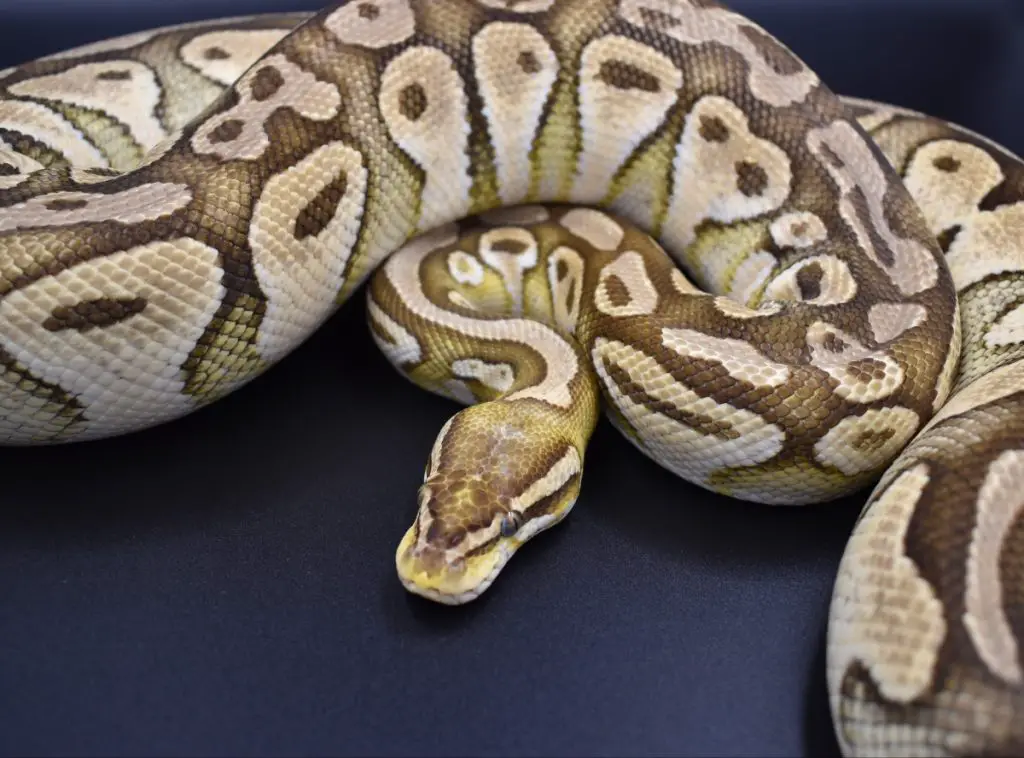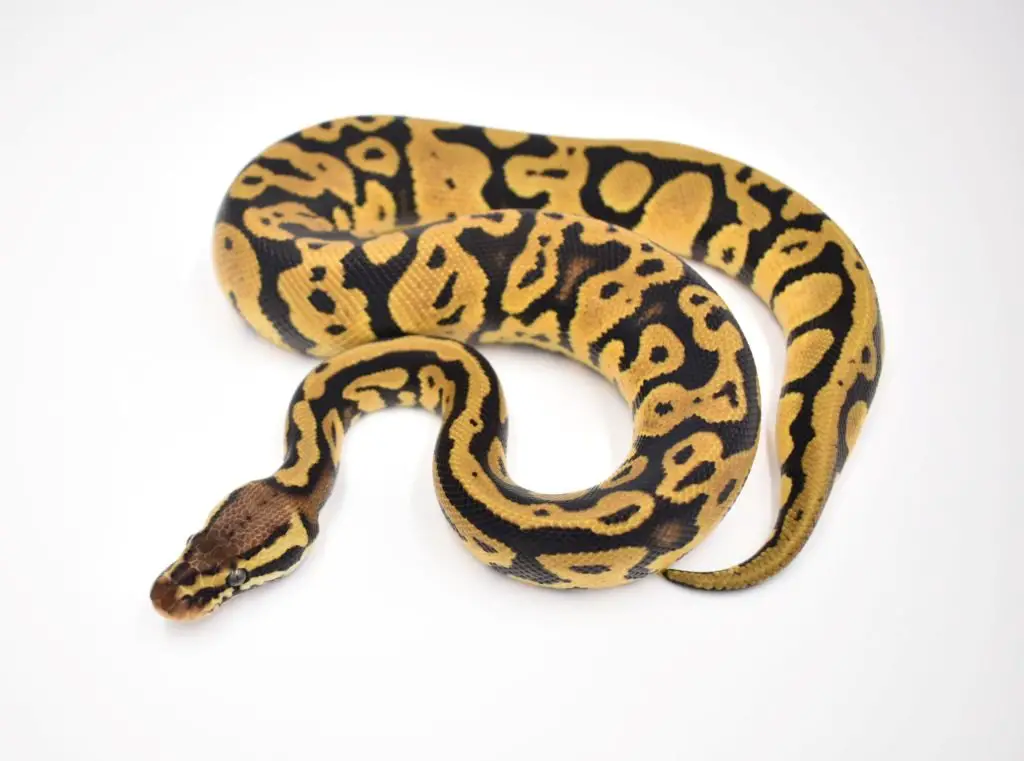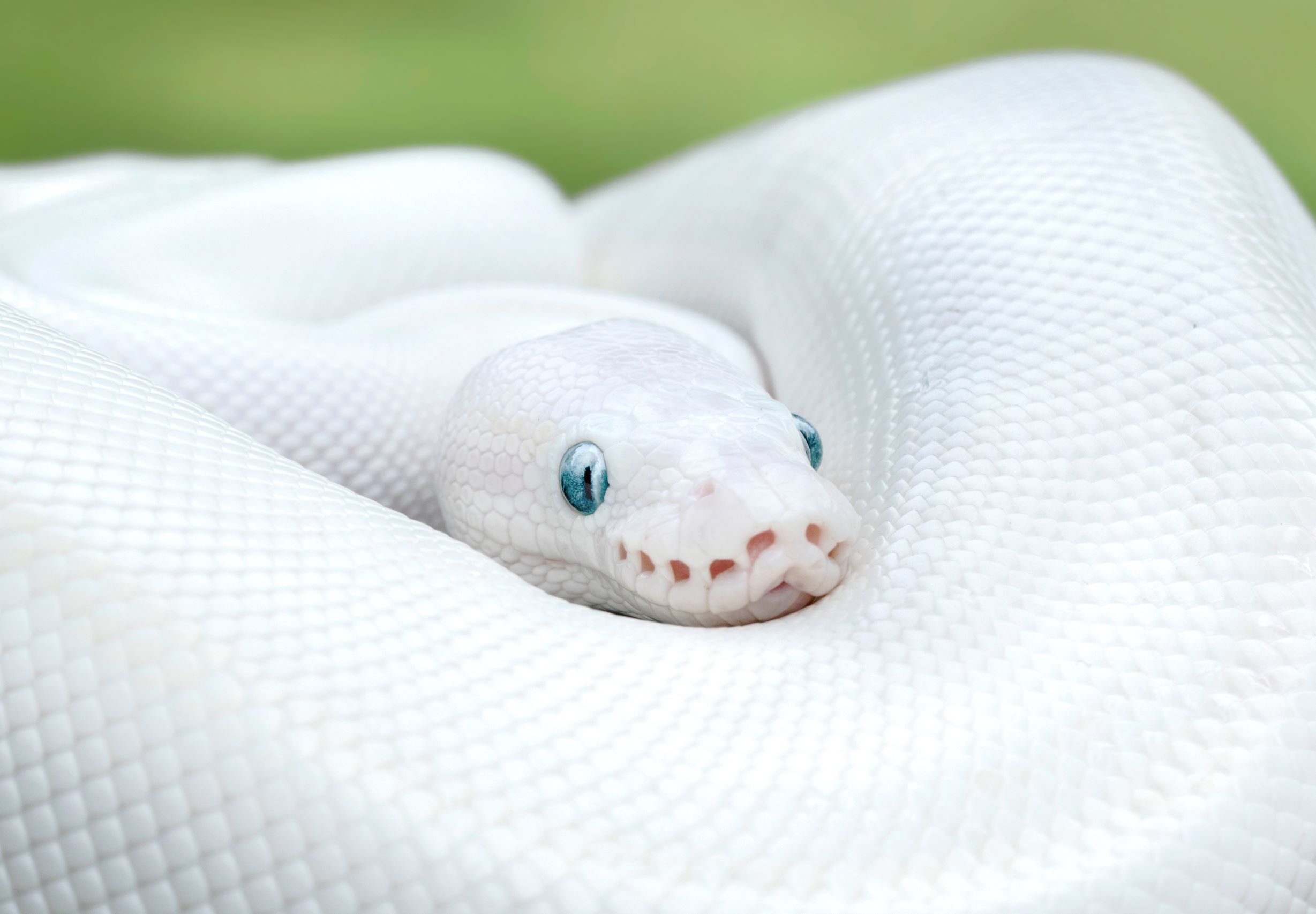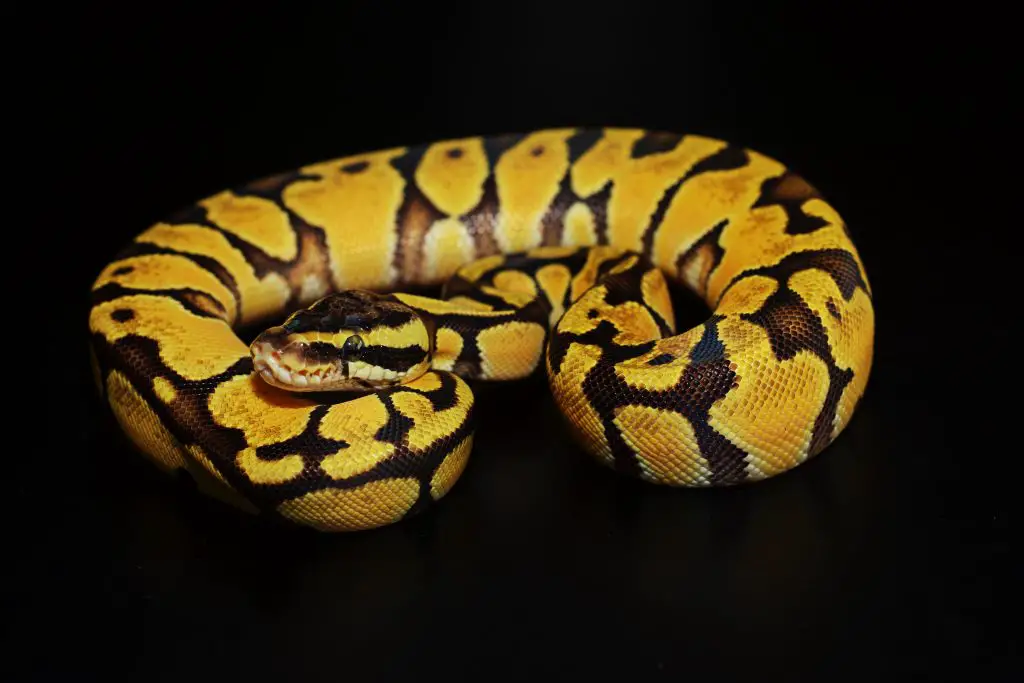Ball Python heating and lighting are two important factors in their husbandry. If you get your snake’s temperature wrong, it’s only a matter of time before it gets sick or stops eating. When it comes to light, the same is true. Be careful though, because too much intense light can actually be bad for this species.
In this post, we’ll an in-depth look at both topics. Then I’ll provide you with some links to articles that cover common questions surrounding how to heat your Ball Python and whether it needs light.
Ball Python Temperature
Maintaining the correct temperature is essential when it comes to encouraging the healthy functioning of a Ball Python’s immune system and metabolism.
As I mentioned before, most of our captive snakes originated from Ghana and Togo, equatorial African countries whose climates undergo some seasonal change, but are generally very warm. If we look at Sokodé. Central Togo, average daytime temperatures range from 82F (28C) in July, to 95F (35C) in February.
By looking at information like this across their geographic range, we can deduce that these animals have not evolved to deal with cold weather. In fact, I have known of Ball Pythons that have contracted sudden respiratory infections after being overnight shipped without proper insulation.
Now it is true that temperatures in parts of their range have been recorded above 104F (40C) during the day and below 68F (20C) at night, but we must remember that these animals generally live in rodent burrows or termite mounds, and occasionally large hollowed out logs. In fact, you may have noticed that they only constrict prey with the first third of their body, whereas snakes in the Boa constrictor group often use most of theirs. This is a direct adaptation for constriction in burrows where room is limited.
Living in a burrow helps maintain steady temperatures
With regards to thermoregulation, burrows have the benefit of attenuating surface heat during the day but retaining some of it at night. Ball Pythons have been found in burrows over 3 ft (1M) in length, where they can go deeper or closer to the surface to thermoregulate. Essentially, the bottom of the burrow is the relatively cool end during the day and then the warm end at night.
All in all, this tells us that a thermal gradient is necessary in the enclosure, without a huge drop in nighttime temperatures (despite being nocturnal, they retreat to a warm burrow if they get too cool while on the prowl). In captivity we achieve this by having an enclosure with a warm end and a cool end, with a hiding place in each.

What temperatures for a ball python?
Personally, I measure the success of my parameters by observing the snakes’ feeding response over time. The best seasonally adjusted feeding response from my snakes has been achieved with a warm end at 90-91F (32C) and a cool end at 80-81F (27C). Generally, I only allow a small drop in temperature at night which can be achieved using thermostats with a nighttime drop option (I wouldn’t say this is essential though if your house cools down at night anyway).
A lot of people are now giving recommended basking spot temperatures in care sheets and promoting heat from above rather than heat mats, but I will explain in the Heating section why it doesn’t matter where the heat comes from – and go into where and how to measure temperatures.
Summary: Warm end 90-91F (32C), Cool end 80-81F (27C), Nighttime drop 4F (2C) lower temp. at both ends.
Ball Python Heating
Ah, and now we get to that old argument, heat from above vs heat from below! It’s an utterly pointless argument, especially as Ball Pythons are nocturnal and rarely bask unless gravid or brooding. Sorry heat from above people – but just because the sun heats everything from above, that doesn’t mean that it makes a difference where your snake’s heat comes from. What you need to remember is that during the day a healthy Ball Python will spend most of its time hiding, and therefore gain (or lose) most of its heat through its belly.
Where the heat comes from doesn’t matter, but if the substrate your snake is lying on is too cool then heat will move out of it and into that substrate – that’s just how heat behaves, whatever the source of it may be. So, if you want to get the temperature right, then heat the enclosure however you like, just make sure you are measuring it under the hides if using heat mats or adjacent to the hides if using heat from above (i.e. lamps/ceramic heat emitters).

Are heat mats good for Ball Pythons?
Personally, I think heat mats are great for ball pythons. They provide gentle heat that replicates the warmth they would get from a burrow in the wild. For my snakes that have mats, I place both both a thermostat probe and a digital thermometer probe underneath the enclosure on the warm side. I secure them with perforated surgical tape and place the thermometer display in front of the enclosure.
This is a particularly good way of keeping heat pads at a safe temperature. If you do use this method, remember that if a cool snake goes and sits on top of the thermometer probe it will read a lower temperature until the animal warms up – don’t turn up the thermostat in this case! Get the temperature right without the animal in there first, then use the thermometer probes and a thermometer gun to double check temperatures daily when the snake is in there.
Now, I’ve mentioned digital thermometers and thermometer guns here for a reason: though essential for controlling your temperatures, a lot of thermostats are actually off by a few degrees. You should always place a thermometer probe close to your thermostat probe. Generally, a thermometer will be more reliable and helps you adjust the thermostat.
Perforated surgical tape is useful for keeping thermostat probes in place. You can use glue or silicone instead, but risk damaging your probe if you ever remove it.
Best heating appliances for Ball Pythons
As I mentioned earlier, heat mats are a great way to heat your snake from below. Mats work well if mounted on the outside (underneath) of plastic tubs and glass vivariums, as long as these are raised on furniture stoppers to allow for a little air circulation. Never place them inside these types of enclosures. In wooden vivariums heat mats can be used inside as long as they are in a special mat holder, and the thermostat/thermometer probes fastened to the top of it. If you chose this method make sure it is a decent holder – I have seen some useless ones.
Never ever use a mat without a thermostat; they can cause severe burns at relatively low temperatures due to the way heat can build up under heavy bodied snakes (referred to as thermal blocking). When using a heat mat, it should be placed under the warm hide. A mat that covers more than 30-40% of an enclosure’s floor space may make it hard to create a thermal gradient.

Other heating appliances for Ball Pythons
Heat bulbs should only be used if you can find a “night time” one – usually dark red or blue. A bright bulb as a heat source = all day and no night! That said, bulbs work well as long as the enclosure is big enough to allow for a thermal gradient to occur, and are housed in a metal cage to prevent your snake from burning its snout. Other than the fact that they make it harder to maintain humidity, it is worth mentioning that bulbs cost more to run than mats, especially if you choose the wrong wattage. It sounds counter-intuitive, but in a 3 foot (90CM) vivarium, a 50 watt bulb will struggle and cost more than a 100 watt bulb.
Ceramic heat emitters work like bulbs, but are more efficient, more powerful, and make no light – in fact they’re better all round! Like bulbs, they do of course heat the air and lower humidity, but as I said before, orchid bark, sphagnum moss and misting can help with this. Heat emitters can cause severe burns and do need to be in a metal cage.
Bulbs and heat emitters should be fitted at one end of a vivarium rather than the middle, and be at least 6 inches (15CM) from each wall. They are not suited to plastic tubs.
Last but definitely least – heat rocks are awful! They don’t work well with thermostats, are usually too small and cause more burns than any other heating appliance. Never use a heat rock!
Recently, another type of heating appliance has appeared on the market: the reptile radiator, or radiant heat panel. As far as I can tell, these work well when mounted to the ceiling of the enclosure, and are considered safer than either heat bulbs or heat emitters.
Thermostats for Ball Pythons
Now that I’ve discussed the main types of heating appliances, lets take a look at thermostats. There are a number of brands, but three main types: dimming, pulse proportional and on/off. Always make sure that a thermostat is the correct wattage for the appliance you want to use it for.
Dimming thermostats are designed for use with heat bulbs, dimming and brightening them to control temperatures.
Pulse proportional thermostats send pulses of electricity to an appliance at a varying frequency to control temperatures. These are great for heat mats and ceramic heat emitters. They would wreck light bulbs though by making them flicker constantly.
On/off thermostats are fine for keeping heat mats safe, but not very accurate. They get to the set temperature, turn off, then cool down by several degrees before switching on again.
Don’t forget, different appliances need different thermostats! Check out the table below:
| Appliance type: | Thermostat type: |
| Heat bulb | Dimming thermostat |
| Ceramic heat emitter | Pulse-proportional thermostat |
| Heat mat | Pulse-proportional thermostat or On/Off thermostat |
| Radiant heat panel | Pulse-proportional thermostat |

Ball Python Lighting
Constant bright light is not really appropriate for this species, unless they can retreat into a very dark hide. In fact, constant, strong overhead light can lower feeding response over time by stressing the snake.
Ball pythons need ambient light only, which can simply be light from a window in the room. Just make sure their enclosure isn’t exposed to direct sunlight, as this could overheat it.
Are Ball Pythons Crepuscular?
Recently a myth has started to emerge that Ball Pythons are crepuscular rather than nocturnal – but having slept in the same room as this species since I was 12 years old, I can tell you that it simply isn’t the case. Ball Pythons are nocturnal and crepuscular.
This myth has been created by manipulating a scientific study to suit those that want to sell you UV bulbs.
Basically there was a study that found that Ball Python eyes have evolved to respond to UV light. Some enterprising Ball Python “specialists” decided that hey, this must mean Ball Pythons are fully crepuscular and need UV! Cha-ching!
In fact, the eyes of hundreds of species of both diurnal and nocturnal animals respond to UV light and detect it. Nocturnal animals have powerful eyes that make the most of any light available, so yes their eyes detect UV light – doesn’t make them crepuscular or diurnal though!

Do Ball Pythons Bask?
The second point these people make is that some Ball Pythons bask – so they must need it! Again, this is an interpretation by people who have little experience with the species. Female ball pythons will bask when gravid or brooding a clutch, and others will bask if temperatures are too low in their hideout. It’s not for UVB though, it’s to warm themselves up or to use this heat to warm up their eggs!
So when people tell you that Ball Pythons do need UV light – the proof being that their snakes bask – it usually comes down to the fact that their snakes don’t have heat pads so have to bask to warm themselves! In the wild, their burrows retain the heat from the day, making basking unnecessary most of the time.
Watch out for misinformation like this, as it helps to sell UV bulbs – not care for your snake appropriately.
The majority of these snakes are in fact nocturnal, being active on and off between 8 PM and 6 AM generally. Some of my snakes are more active around dusk, but not to bask. In fact, it’s usually because they’re hungry and getting impatient.
As a result, Ball Pythons have evolved to take up the necessary vitamin D from their prey rather than synthesising it with the aid of sunlight. The ambient daytime light that comes through your windows is perfectly adequate for their circadian rhythm, and specialised lighting is unnecessary.
Ok, so UVB isn’t essential for Ball Pythons, but can I give it to them anyway?
There’s nothing wrong with setting up a light in a vivarium and putting it on for just 4-6 hours a day – it’s entirely up to you and the odd exposure to UV light can’t do any harm.
More on this subject:
- Temperature for a Ball Python: what you need to know!
- The truth about Ball Python lighting
- Ball Python Care topics:
- Intro
- Enclosure guidelines
- Bedding and refugia
- Heat and Light *You are here
- Humidity, water, and shedding
- Ball Python Size
- Handling
- Diet
- Health and hygiene
- Breeding
- Eggs and incubation
